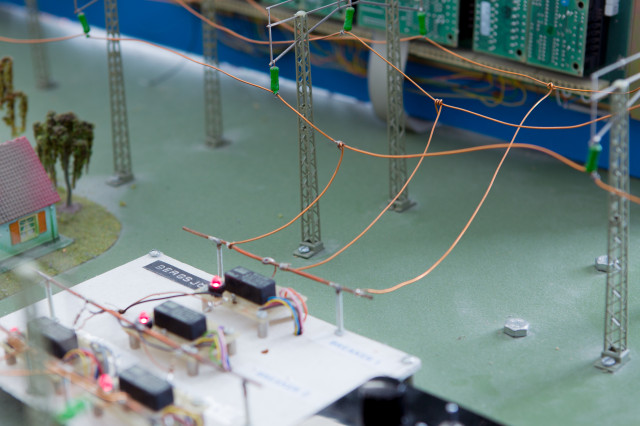- Magnetic circuits and their application to electric machines.
- Theory of MMF waves (including harmonics) and how this is applied on electric machines
- Calculation of flux density by means of magnetic circuits.
- The equivalent circuit of the induction machine derived by means of the theory of MMF waves
- Losses in induction machines.
- Electromagnetic design principles of induction machines.
- Thermal dimensioning of induction machines.
- Equivalent circuit of the permanent-magnet synchronous machine derived by means of the theory of MMF waves
- Electromagnetic design principles of synchronous machines.
- The finite element method to solve magnetic problems.
EJ2223 Design of Electrical Machines 7.5 credits

Asynchronous and synchronous machines are central components in industrial operations, electrified transport solutions and energy generation. Their related theory represents an important and interesting application of the low-frequency approximation of Maxwell's equations. The goal of this course is to present the theory of alternating current machines at a more fundamental level than presented in basic courses, and answers a simple question: how do you construct an electrical machine? After the course, the student must be well prepared to apply the theory in various applications at development or research level.
Information per course offering
Choose semester and course offering to see current information and more about the course, such as course syllabus, study period, and application information.
Information for Spring 2025 Start 17 Mar 2025 programme students
- Course location
KTH Campus
- Duration
- 17 Mar 2025 - 2 Jun 2025
- Periods
- P4 (7.5 hp)
- Pace of study
50%
- Application code
60055
- Form of study
Normal Daytime
- Language of instruction
English
- Course memo
- Course memo is not published
- Number of places
Places are not limited
- Target group
Open for all master programmes as long as it can be included in your programme.
- Planned modular schedule
- [object Object]
- Schedule
Contact
Course syllabus as PDF
Please note: all information from the Course syllabus is available on this page in an accessible format.
Course syllabus EJ2223 (Spring 2025–)Content and learning outcomes
Course contents
Intended learning outcomes
After passing the course, the student should be able to
- Use the theory of magnetomotive force (MMF) including MMF waves, to decide magnetic flux density, inductances and magnetic limitations of electric machines
- Analytically calculate stator and rotor resistance, magnetizing inductance and leakage inductance components for induction machines and equivalent parameters for permanent-magnet synchronous machines
- Use the finite element method (FEM) to calculate magnetic and electromechanical performance of induction machines and permanent-magnet synchronous machines
- Design an induction machine and a permanent-magnet synchronous machine for a given requirement of torque given requirements on energy efficiency and thermal limitations
- Extract FEM data to implement transient models of permanent-magnet synchronous machines that include magnetic saturation, magnetic cross-saturation and harmonics
- carry out FEM calculations to calculate the resulting temperature distribution in an electric machine for a given torque and speed
in order to be able to use Maxwell's equations and basic principles in thermodynamics to analyse and design electric machines.
Literature and preparations
Specific prerequisites
- Knowledge in electromagnetic field theory, 6 higher education credits, equivalent completed course EI1320/EI1228 or completed items TENE and TENM in EI1220.
- Knowledge in electric machines and drive systems, 6 higher education credits, equivalent completed course EJ2201.
Literature
Examination and completion
If the course is discontinued, students may request to be examined during the following two academic years.
Grading scale
Examination
- PROA - Project work, 4.5 credits, grading scale: A, B, C, D, E, FX, F
- PROB - Project work, 3.0 credits, grading scale: A, B, C, D, E, FX, F
Based on recommendation from KTH’s coordinator for disabilities, the examiner will decide how to adapt an examination for students with documented disability.
The examiner may apply another examination format when re-examining individual students.
Examiner
Ethical approach
- All members of a group are responsible for the group's work.
- In any assessment, every student shall honestly disclose any help received and sources used.
- In an oral assessment, every student shall be able to present and answer questions about the entire assignment and solution.